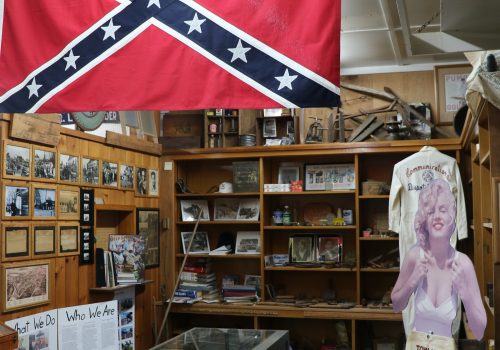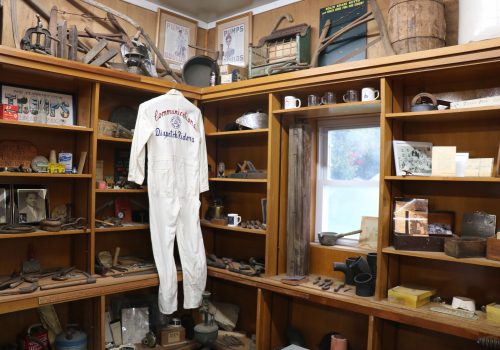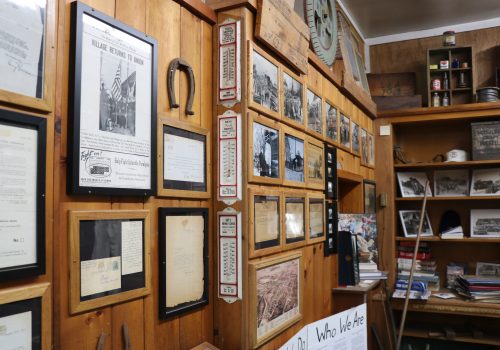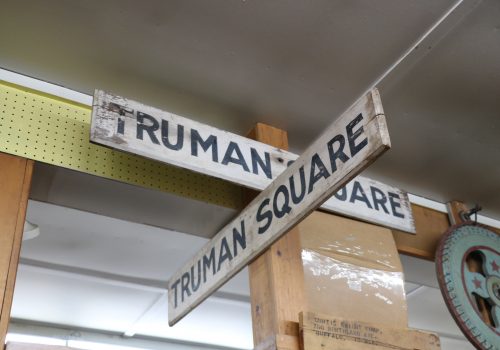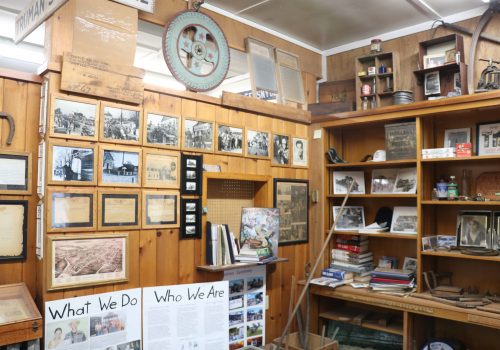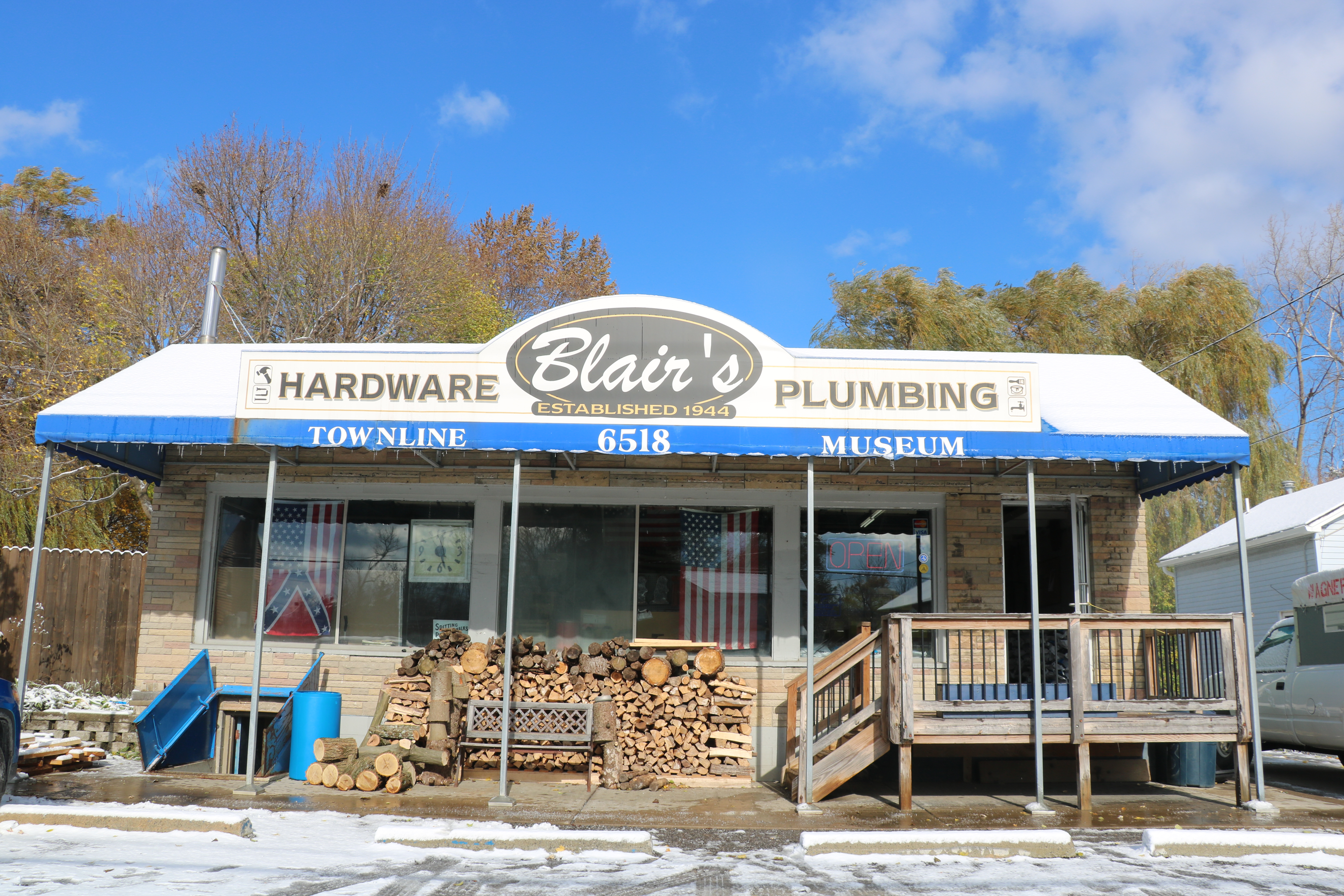
Blair’s Hardware Store is located in Town Line, NY and is owned and run by Lisa and Bryce Blair. The store was established in 1944 and has come to house a small, informal museum dedicated to the history of Town Line and the town’s secession in particular. The archival material found in Blair’s constitutes a large portion of the source material on this site. Included below is an interview with Lisa Blair, who runs both the store and the Town Line museum inside.
Interview with Lisa Blair of Blair’s Hardware Store
Transcript edited for clarity from November 10th, 2018.
Julia: The first question is just very general, and we’d like you to tell us about yourself and your job.
Lisa: Oh! Okay, well I started working here about 25 years ago. The family has owned this business since 1944. We bought it from a family who had it just after the Civil War (the King family) and my father-in-law started the business over again with his dad. And it’s been a family-run business since that time. All the wives do the paperwork. None of the guys ever liked paperwork. So we became the historians, the paperwork people. There’s a picture up front of me, my mom, my grandma – we always worked here and it’s always been family. So when mom and dad both got sick, my husband and I closed our business down (Blair’s Construction) and came into the family business. That’s where I’ve been for 25 years. We sell hardware, obviously. Plumbing – we do plumbing, and history dabbled on the side. But that’s about it, nothing special.
Julia: So along with that, what’s your personal relation with the history, the town, the secession…?
Lisa: Well, long story short, my father-in law- (who died July 6th of this year) told my girls the story, and my daughters loved history, both of them, and the eldest decided to write her college paper about it. And in the process, when we first looked, there was nothing online – nothing anywhere. So she went and interviewed people we knew from the business – customers, family, people like that who knew about it, her grandfather – and we kinda pieced together little bits of what it was. And we went online and found only one thing, and it was a mold that made the commemorative tokens that they gave away during the rejoining. So I’ve never bought anything on eBay or anything like that, so I decided I was going to try it. Well, afterwards, everybody tells me, “Oh, you don’t do it ‘til the last day!” No, I started bidding from the very first day. So somebody else sat there and bidded against me every single day, driving the price up until it was $85. So I said “Okay, I’m not going to spend anymore money”, and I waited that tick-tock-tick-tock until it was done. And yes, as they say, I won the bid, and we got it to bring back home. And I put it on the shelf like you saw in the video, and the newspaper found out about it and they did a little story about my daughter’s paper. And that’s when all of a sudden everybody brought their stuff to put here, and my shelf grew until the point that I lost my office and I filled it up with a little museum. So it wasn’t anything planned. It was something I adopted and never said “no” to. It was at the anniversary of the Civil War beginning the Alden Historical Society asked if I’d give a little story about it. And we expected about 60 people, and we were gonna do it in the senior center in Alden. Well as it got out there, more and more people wanted to get involved. We had people from different museums. The venue just became too small. The Lancaster Historical Society helped out, we got a bunch of different people’s stuff together, we asked the church if we could use theirs because they were here at the time and they said no problem. And once 300 people got there we said, “We can’t fit no more,” and had to turn a bunch of people away. There were re-enactors outside with their cannons and their fires and it was a really neat event. But that poured in a whole bunch more stuff for me to store. We got the Truman Square signs that was put… Little story about that, side bar: the Truman Square signs were there on the corner for the event, but then they were separated. One was put on the Lancaster side and one was put on the Alden side and they stayed there until they widened Broadway, and then they disappeared. Nobody knew what happened to them. And during the event, the gentleman who saw the road getting widened was fearful that they would disappear. He had taken them and stored them in a garage, and he came to the event with them under his arm and he said, “Honey, if they stay in Town Line, you can keep them.” So we hung them up there and that’s where those signs came from. But it was just something that was gathered, like a rolling stone gathering moss, it just kept collecting and collecting and it is what you see there now.
Julia: And you touched on it a little, but your involvement in this museum and preserving the history?
Lisa: Well I don’t know how to do it. All I’ve ever done was try the best I could to make it last. I’ve wanted to find people that might have been interested like you guys that would know how to do it properly, but never ran into anybody who had the ability. So what I’ve done was just, the one little, old gentleman that I was telling you about that I love, he made me all the frames for the pictures on the wall. You know, there’s a lot of love out of it from different people who brought their own things. Newspaper clippings that people had, the pictures I’ve got – is the most complete collection because it’s come from three different families – because some had different pictures that they had preserved. It’s just an eclectic collection. Even when I’m not here, people drop stuff off and tell my girl that works with me, “Here, give them to her, see what she can do with them,” and I just try to do something with them! I have a few more things that I haven’t had a chance to do anything with. There’s a lot of newspaper clippings that are put in the old-fashioned black books that are stuck to the pages that now I can’t get apart and don’t know how to properly preserve but… Maybe someday somebody will want to adopt it, take it on a little further, but this is amateur hour. I have no intelligence to give you in that.
Julia: How often do people come and give you more material?
Lisa: It has slowed down after a while because there’s not a whole lot more left, but what’s neat to see is that I didn’t realize how far the story was getting spread. There’s people that come up here when they’re on vacation and they stop and see it. We’ve had a lot of different southern groups. Different people, like about two years ago (maybe three) ,Mr. Early, who’s a direct relation to Jubal Early, he came here to see about Town Line. He had heard about it. Mr. Jubal Early – he was involved in the Civil War – and this gentleman had heard about the northern guys that came down south to fight. And he wanted to know about Town Line’s story and he wanted to include it in his book, which is up there in the museum. And in the process of us talking, he talked to some of the groups down south, the Daughters of the Confederacy and the groups on the poster in the collection. They raised funds to have that historical placard put outside, and then we did a dedication ceremony for that. So then there was a few more things because of the hype that happened with it that came in little bits and pieces of history. But of recently I haven’t really, of the last year, gotten anything else. It’s just kinda slowed down. I don’t think there’s a lot more left (other than those original letters of secession) to be found, it’s become quite a complete little set up of a lot of stuff – a lot of eclectic gifts – that someday might be in a real museum.
Julia: I know you said you’re an amateur, but if you had to give yourself a title, would you give yourself a curator or a historian title?
Lisa: No. “Curious”. That’s about it. I have no background in anything other than the fact that I love the story. My daughters loved the story. Maybe that’s why I liked it so much – ‘cause my girls used to listen to their grandpa, and the history. It was nice to see they had an interest in history.
Julia: Do you have any immediate plans with like the material in the collection?
Lisa: No. I do wonder someday when I retire what would be done with it. I don’t want it to be separated. It took so long to gather it together. I’d love to see it go some place that would take care of it like I want it to be. That is something I always think about ‘cause I’m not gonna live forever. And somebody like you guys, maybe you’d adopt the project. Find some home for it someday. I do look… I like to travel. I like to go down south and see things. We’ve been to Williamsburg, we’ve been to Gettysburg, we’ve, you know, tried to learn a lot more about history ourselves because of it. It would be nice if a museum someday would like to have it. I’d gladly let them because I know they’ll preserve it – but not hide it. That’s another fear. I don’t want it to be hidden from view because it tells such a quaint, personal story about people and how they were back then.
Julia: Okay, switching gears a little bit: do you have an opinion or a guess on what the true reason for secession was?
Lisa: Well, from a few people that I have talked to who have had a long history of people living here, going right back to the original purchase of properties in this area: there were different groups who were trying to settle here – German descent, Jewish descent, different families that came because of strifes they were having back then. The German families that came to settle here were trying to get away from the un-unified Germany. That township-against-township and dictator-against-dictator that would tell these people, “Your sons have to fight in our war”. They would like to have peace. And they were very good at woodworking, steel working, wine-making, and the environment here was very similar. So they came and settled here and thought they got away from all of that. They thought they were going to come to a country that finally got it right. They were gonna be a unified group of people, and then they hear about the Civil War. And they were upset that people couldn’t communicate and fix a problem rather than fight over it again. And I believe that’s probably more of the reasoning it happened. I can’t prove it one way another, other than people’s opinions on family stories that were passed on, but our history’s nothing but that.
Julia: Okay, so you told us a little bit about the two plaques, but do you have any other information to provide us? On the difference between them, who erected both of them?
Lisa: Oh! The Alden Historical Society did the one on the stone and it was very nice. What they’re doing there is they were dedicating the spot where the actual blacksmith shop sat. The other one, that was here. And yes, there was a little controversy done by some local newspapers that said there was some big deal about the south coming up here, which isn’t true. Mr. Early had been talking to me long before that stone was even thought about and we just had parallel things at the same time. They wanted to dedicate something here because this business has been here since that time. My husband’s grandfather was involved in the parade and Grandma was involved in the Ladies Auxiliary at the time of the vote, and she and the Ladies Auxiliary (and this is a funny women’s joke) voted no just so it wasn’t unanimous. So yes, the family had been involved in this and they wanted to have a plaque dedicating upfront about the community. And that there was a little bit of southern pride in the community. And that’s where they wrote that plaque and dedicated it. There was no controversy, really.
Julia: Similar, but on a different note – what do you know about when the confederate flag was taken off of the fire department logo in 2011?
Lisa: Okay, a lot of the guys who were involved in the fire department had a pride of that, and it wasn’t for the fact of being a racist thing. Because people here also smuggled slaves across to Canada. They had a pride in that that was for different reasons. It was to try to show that we the people still had strength and power to tell our government, “No, we don’t like things like this.” That’s what the people thought, but the problem had come into play that the fire department went on parade and they would have this on their uniform. And other people would be upset about it from other places that didn’t know the story. And they tried to tell the story, but when this controversy started happening, it was right in the beginning when we started gathering stuff up for this museum and it was before there was anybody to send out a rally cry. So they lost the war on keeping that on their uniform. Powers that be basically pushed them into getting rid of it, saying that it was a racist symbol. And we bowed down to it, but there was a lot of guys who left the fire hall because of it. And out of protest they took their old patch out of their uniform and they brought it here for me to store in the museum. So I have many patches from many guys who said goodbye.
We would like to thank Lisa Blair for giving her time to talk with us about the town’s history, for showing us the many materials she curates related to the secession and reunion, and for her dedication to preserving and sharing Town Line’s quaint but important story.
All photos taken by Julia McGaugh at Blair’s Hardware on Oct. 19 and Nov. 10, 2018.



